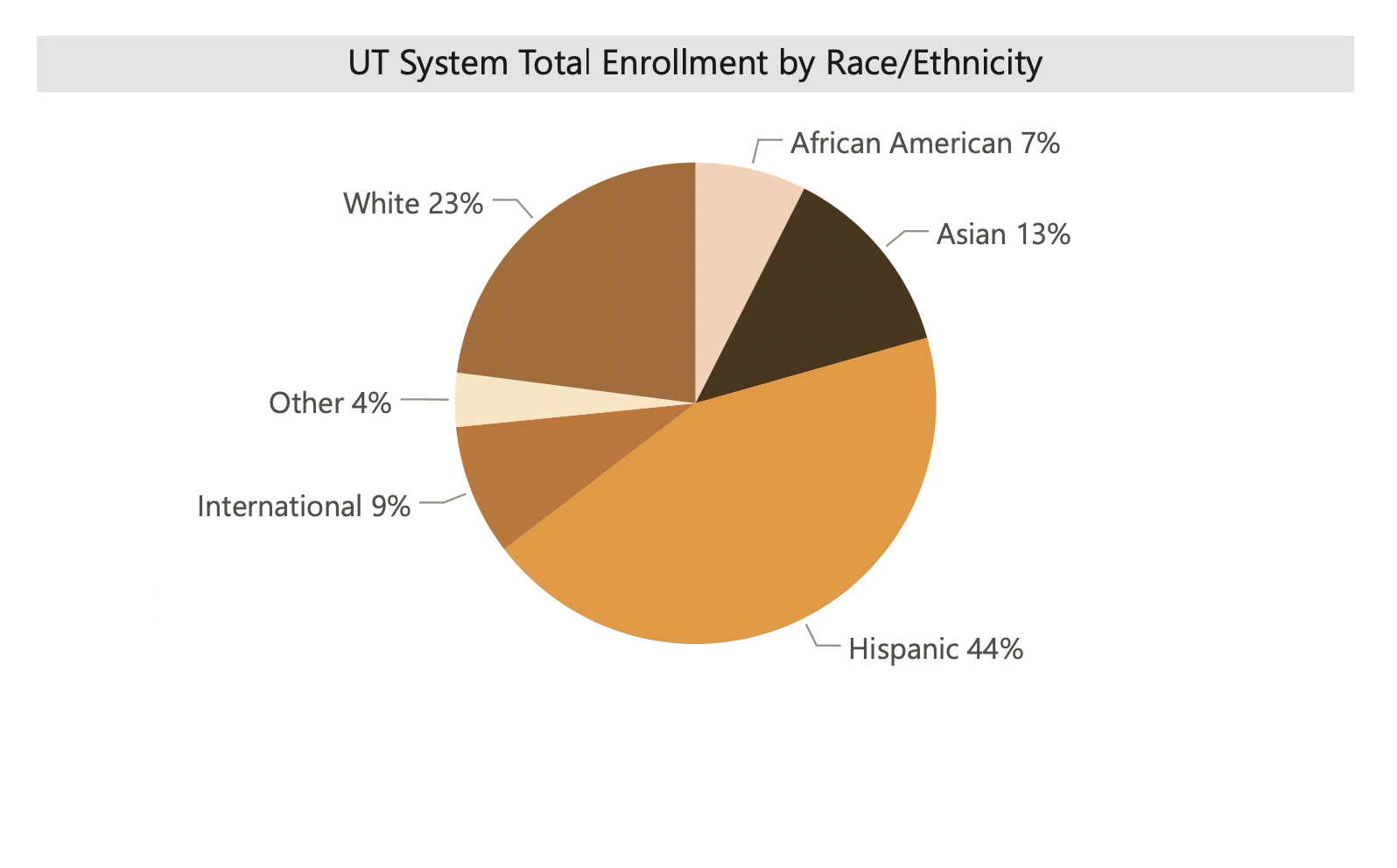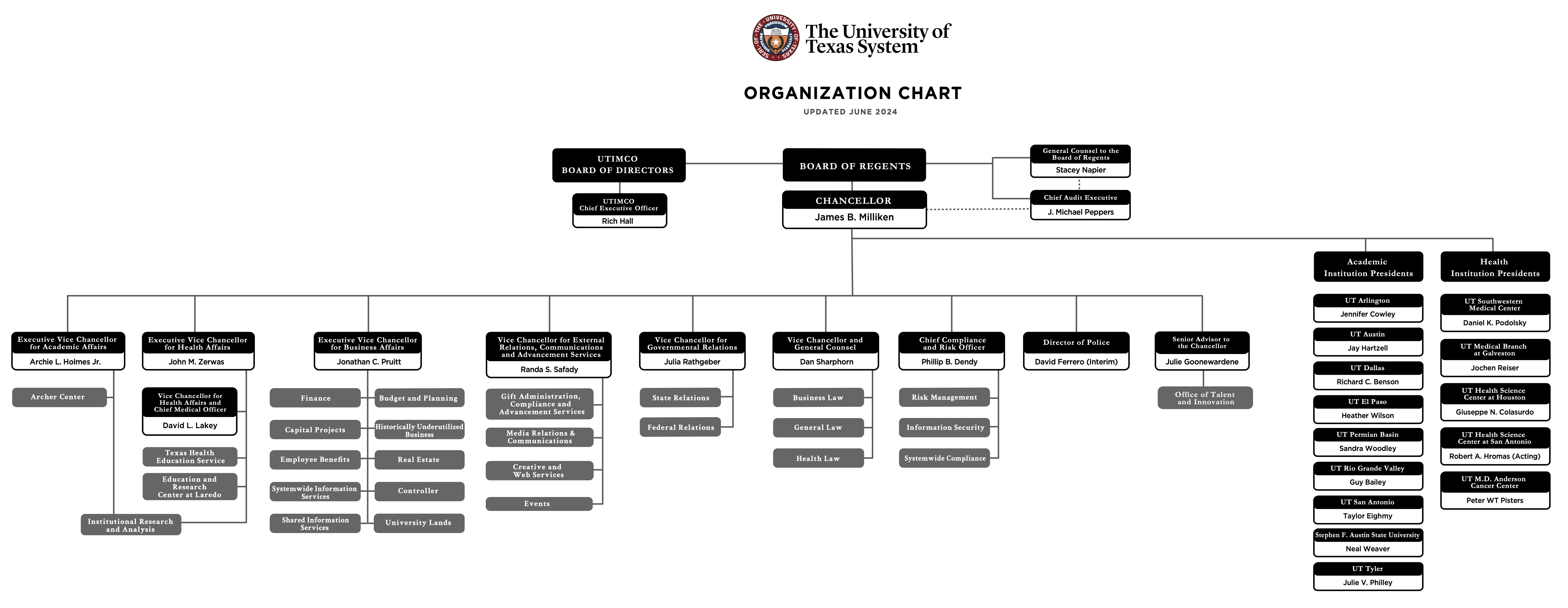The University of Texas System (UT System) is a network of public universities run by the State of Texas. It includes eight universities and six health institutions. Founded in 1881 with the opening of UT Austin, the University of Texas System has evolved into one of the largest and most influential public university systems in the United States.
The University of Texas System has a total enrollment of about 240,000 students and an operating budget of $23 billion. The UT System’s administrative headquarters is in Austin. The system as a whole employs about 21,000 faculty and 83,000 staff, researchers, and health care professionals.
Each year, UT institutions award approximately one-third of undergraduate degrees in Texas and about 60% of the state’s medical degrees. (The UT System is one of several state university systems in Texas, alongside Texas A&M, Texas State, Texas Tech, and others).
Campuses

The UT System’s geographic reach spans the entire state, ensuring that students from urban, rural, and border regions have access to high-quality education and healthcare. Each campus has its own strategic focus, shaped by regional needs and statewide goals.
The eight UT System universities are located in Arlington, Austin, Dallas, El Paso, the Rio Grande Valley, San Antonio, Tyler, and the Permian Basin. The largest UT institution by student enrollment is UT Austin with more than 50,000 students.
The UT System health institutions include medical schools in Austin, Galveston, San Antonio, and Houston, the MD Anderson Cancer Center in Houston, and a health science center in Tyler.
Academics
The University of Texas System offers a broad spectrum of academic programs across its 14 institutions, serving both undergraduate and graduate students. Its flagship, UT Austin, offers more than 170 undergraduate and 200 graduate programs, including engineering, business, law, natural sciences, liberal arts, and computer science.

Each campus within the system contributes to the state’s educational and workforce needs. UT Arlington has become a leader in nursing, engineering, and urban research, while UT Rio Grande Valley focuses on health sciences. Regional universities such as UT Tyler, UT Permian Basin, and UT San Antonio emphasize professional training, teacher education, and industry partnerships tailored to local economies.
To support working adults and nontraditional students, the UT System offers a range of flexible learning options, including fully online degree programs, hybrid formats, and accelerated pathways. Graduate offerings span high-demand fields such as cybersecurity, public health, education, and urban planning, with many programs designed in collaboration with employers and state agencies.
Demographics

Tuition and Fees
Tuition and fees vary across the UT System. The figures below represent the average amounts charged to resident undergraduates enrolled in 15 semester credit hours in the fall semester 2022, as reported by the Texas Higher Education Coordinating Board:
- UT Permian Basin: $4,842
- UT Arlington: $5,864
- UT Austin: $5,849
- UT Dallas: $8,206
- UT El Paso: $5,098
- UT San Antonio: $5,867
- UT Tyler: $5,144
- UT Rio Grande Valley: $4,521
- Statewide average (public universities): $5,252
A student’s actual charges may vary based on the student’s classification and level of enrollment, the college the student attends within the university, the student’s specific personal circumstances, and other factors.
Financial aid options across the UT System include need-based grants, merit scholarships, and work-study programs. In recent years, several UT campuses—including UT Austin and UT Rio Grande Valley—have launched initiatives to cover tuition for low-income students through endowment funding and state support, helping reduce barriers to college access.
“The mission of The University of Texas System is to improve the human condition in Texas, our nation and our world. The System will use its size, diversity, and quality to advance education, push the bounds of discovery, enhance population health, build stronger communities and shape public policy for the common good. Producing high quality human capital with a sense of service and the ability to lead, we will pursue solutions to the problems of our state, our nation and our world. We are a state university system with global impact.”
Mission Statement of the University of Texas System
University Funding
The University of Texas System receives funding from a variety of public and private sources. One of its foundational assets is the Permanent University Fund (PUF), established by the Texas Constitution of 1876. Originally endowed with roughly one million acres of West Texas land, the PUF now comprises more than 2.1 million acres and substantial financial investments. Revenues from mineral rights—particularly oil and gas leases—as well as grazing and other land uses continue to support UT institutions, primarily UT Austin and UT El Paso.
Other key sources of funding include state appropriations, tuition and fees, hospital and clinical revenues, private gifts, and investment income. The UT System’s endowment is among the largest of any public university system in the United States and is managed by UTIMCO (University of Texas/Texas A&M Investment Management Company), which oversees the investment of funds on behalf of both the UT and Texas A&M systems.
Research is another critical component of the UT System’s financial ecosystem and public mission. UT institutions collectively secure billions of dollars in external research funding each year, fueling discoveries that benefit both Texas and the broader world. Flagship campuses like UT Austin and the MD Anderson Cancer Center consistently rank among the nation’s top recipients of federal research grants. These funds support cutting-edge work in biotechnology, artificial intelligence, energy, and public health.
Board of Regents
The University of Texas System is governed by a board of regents, composed of nine members who are appointed by the governor and confirmed by the senate.
The Board of Regents sets overall policy for the UT System, approves budgets and tuition rates, and oversees major capital projects. Regents also appoint the chancellor and university presidents, evaluate their performance, and guide long-term strategic planning. Through regular meetings and committee work, the board ensures that UT institutions fulfill the system’s mission and respond to the educational and economic priorities of Texas.
Terms for regents are scheduled for six years each and staggered so that three members’ terms will usually expire on February 1 of odd-numbered years. In addition, the governor appoints a student regent for a one-year term.
Administration

The chancellor is the chief executive officer of the UT System and reports directly to the board of regents. As the system’s top administrator, the chancellor provides strategic leadership across all 14 institutions, ensures alignment with systemwide goals, and represents the UT System in matters of policy, planning, and public affairs.
The administration of the UT System is further organized into six executive offices, each headed by an executive vice chancellor or vice chancellor:
- Office of Academic Affairs
- Office of Health Affairs
- Office of Business Affairs
- Office of External Relations, Communications and Advancement Services
- Office of General Counsel
- Office of Governmental Relations
These offices are based at the UT System administrative headquarters in downtown Austin, serving as the central coordinating body for the entire university system.
While the chancellor provides overarching leadership and coordination, each UT institution is led by a president who retains operational authority over their respective campus. The system administration offers guidance, resources, and oversight, but respects the autonomy of campus leadership in managing day-to-day academic and administrative affairs.




